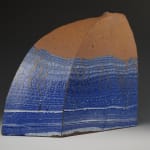Miyashita Zenji 宮下善爾
H27.4 x W33 x D9.6cm
Further images
-
(View a larger image of thumbnail 1
)

-
(View a larger image of thumbnail 2
)

-
(View a larger image of thumbnail 3
)

-
(View a larger image of thumbnail 4
)

-
(View a larger image of thumbnail 5
)

-
(View a larger image of thumbnail 6
)

-
(View a larger image of thumbnail 7
)

-
(View a larger image of thumbnail 8
)

-
(View a larger image of thumbnail 9
)

-
(View a larger image of thumbnail 10
)

-
(View a larger image of thumbnail 11
)

The Kyoto-born potter Miyashita Zenji 宮下善爾 (1939-2012) was the eldest son of the ceramist Miyashita Zenju (1901-1968) and studied alongside Kondo Yutaka 近藤豊 (1932–1983) under Kondō Yūzō (LNT, 1902-1985) and Tomimoto Kenkichi (LNT, 1886-1963). Beginning his ceramic training with the celadon medium, he embarked on a journey that demanded profound mastery of form and meticulous control over the kiln firing process. This journey ultimately grew into one of a celebrated career as a master potter in celadon and most famously, his Saidei techniques. His legacy is enshrined in prestigious institutions such as the British Museum, Metropolitan New York, and Brooklyn Museum, among others.
Miyashita showcased his sensitivity towards color and how it can construct a composition on the surface of his vessels. Employing the "Saidei" technique, a method of colored-clay overlay, he deftly layered pigmented clay in a gradient fashion. One exemplary manifestation of his artistry is found in his indigo glazed designs, reminiscent of water crashing against a cliffside. The deep indigo hues mirror the relentless force of waves sculpting the facade of a rocky canyon wall, culminating in a seamlessly refined surface. His creations stand as testaments to both technical mastery and an acute sensitivity to the expansive potential of color-oriented expression in ceramic art.










